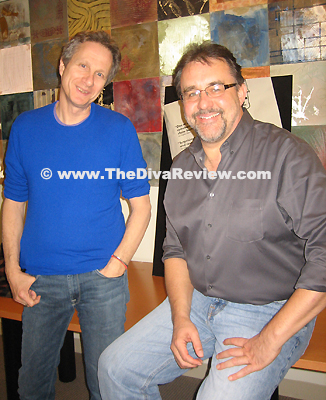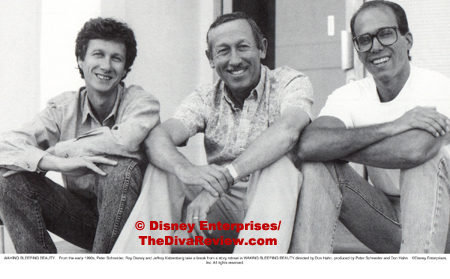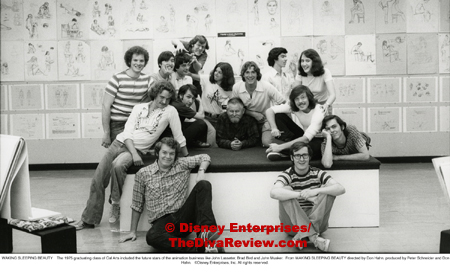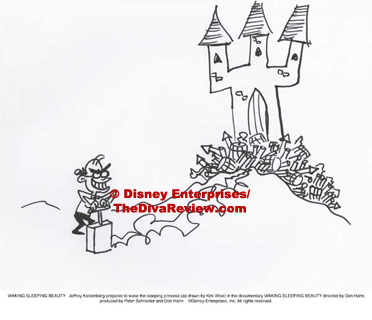
Hey Kids, for those who recall that fractious era when all of showbiz had eyes glued to the drama playing out in the Magic Kingdom, this one’s for you. For the uninitiated, Waking Sleeping Beauty is a true insider’s account of the infamous war between Michael Eisner, Roy Disney and Jeffrey Katzenberg for the future of Walt Disney Studios. A war over art, ego and commerce, the decade-long siege on the Mouse House came very close to completely destroying the Disney animation department. In an exclusive chat, director and longtime Disney animator Don Hahn and producer Peter Schneider talked about life behind the hand-drawn battle lines.
Dig it!
Waking Sleeping Beauty
Don Hahn and Peter Schneider
 The
Lady Miz Diva: Waking Sleeping Beauty gives us a real inside look at a
terrible period in the history of the Walt Disney Studio. The company
is known for being extremely secretive, how did you get away this?
The
Lady Miz Diva: Waking Sleeping Beauty gives us a real inside look at a
terrible period in the history of the Walt Disney Studio. The company
is known for being extremely secretive, how did you get away this?
{All Laugh}
Peter Schneider: I like that! Not “How did you get Disney’s approval?” “How did you get away with it?”
Don Hahn: That’s high praise. I dunno, for some reason we had an advocate in Dick Cook, who was the head of the studio who helped us with financing, and really we had an advocate in all of the participants, including Jeffrey, Michael and Roy. Enough time had passed where it wasn’t going to be a tabloid thriller, but it was really a recollection of the time after 20 years had gone by. And so we had great cooperation and for some reason, they were willing to talk to me. They were willing to trust Peter and I to give us their story, cos we were there. We weren’t outside journalists; we were there, we knew how to interpret their story.
PS: You know, I think we just hit a seam. I’ve been trying to do this for 10 years. I’ve been trying to get it done for 10 years and no one would cooperate. So, for us it was about really putting together these gentlemen, because without Michael, Jeffrey and Roy’s cooperation, there’s no story, is there? So, therefore our goal really was to tell a tale that had not been told and I think that everyone got on to it, there was no resistance. Oddly enough, that was not that hard part. The hard part, which I think Don solved brilliantly, was the technique of how to tell the tale. That was the big breakthrough when Don said, “I wanna do it all with archival footage.”
DH: Cos we had so much, and that wasn’t a given at the beginning because we had budgeted these big shoots. We were gonna get makeup and hair and all that stuff and we had looked at some early tests and footage and we thought, ‘Man, you could see this any night on Frontline.’ You know, guys reminiscing. And the other documentaries and some of the bonus material on the DVDs, they get boring after a while because its just old guys saying “Weren’t we great?” “It was really cool what we did.” And that seemed like a really bad way to go. And we had enough video and archival footage that we could put the whole story together with it.
LMD: I wondered why there wasn’t any recent footage of any of the subjects.
PS: It was completely choice. Everything except for a couple of establishing shots was done before 1994. I think Don really articulates it well about transporting you…
DH: …Into the room. You want it to be voyeuristic; you wanna feel like, ‘I really shouldn’t be here, but I love seeing Howard Ashman work with Jodi Benson and I shouldn’t be here watching it, but I’m so happy to have access to it.’ And so much of this movie has never been seen before. They {the clips} were literally sitting on a shelf for 20 years.
LMD: I’m amazed that the archival footage inside and around the studios exists. The scene when Ron Miller, head of the animation studio at the time walks into the first shot of the home movie footage must’ve been divine intervention.
DH: And it never cuts, that’s the cool thing. {Future head of Pixar} John Lasseter and {Animator} Randy Cartwright, who was onscreen, it was their last week so they said, “Well, let’s go down in flames and just shoot the place. Who cares?” And literally, their first shot rolling, Ron comes out the door and says, “Let’s go in and take a look.” And it was so right for our movie because you hear him say, “We’re making a documentary about the animation department.” It really set up our movie perfectly.
LMD: That clip was shot by John Lasseter, but where did the rest of the footage come from? Who had what and was everyone just willing to contribute to the pool?
DH: Yeah, it came from everywhere. Everybody was willing to contribute to it. We put word out to people. We knew where some clips were, other clips we just let people know we were making the movie. They sent us things; we had tons of stills and drawings and found things in shoeboxes all over the place. And we had a technical problem putting it all together because it was in different media, but that was the least of our problems.
LMD: I presume there’s a lot more that we haven’t seen?
DH: There is. There is 250 hours.
PS: I think what’s so extraordinary – and I haven’t seen all 250 hours - but we’ve captured the essence of those 250 hours. Because all the bonus material and DVD stuff I’m looking at at the moment, it’s not as though it’s any more emotional. It’s an expansion on what’s there.
DH: We were more sure than anything that this was the first and last time we would ever do this. Nobody’s ever gonna make another movie about this period of time and so the driving force behind it all was, ‘Let’s do it right. Let’s get it right and get the story right and be honest about it.’
PS: However, look, Roy’s now dead, right? Roy is no longer around to talk about it. You can’t do the talking head job. You can’t get Roy talking about his past. Someone should have!
 LMD: Thank you for the segue because I wanted to ask about Roy Disney.
It couldn’t have been easy for him to walk around with that face so like
his uncle Walt’s and the weight of the company and family name on his
shoulders. In the film you get a feeling of him as sort of a tragic
prince, though early on he’s called “the idiot nephew.” What was your
take? Do you think he was a fighter for the animation department?
LMD: Thank you for the segue because I wanted to ask about Roy Disney.
It couldn’t have been easy for him to walk around with that face so like
his uncle Walt’s and the weight of the company and family name on his
shoulders. In the film you get a feeling of him as sort of a tragic
prince, though early on he’s called “the idiot nephew.” What was your
take? Do you think he was a fighter for the animation department?
DH: Yeah, clearly he was, he really was. He was really an interesting guy; it’s not that he was there all the time. It’s not that he came up with story ideas or whatever, but you knew that somebody with the Disney name was on your side. And if there was a battle to fight, or a computer system to buy, there’d be somebody you could go to who would be your advocate.
PS: I would say more than that. I would say that without Roy putting his body in front of Michael and Jeffrey when they first came to the company, animation would not have ever had the success it has today. Without him saying, ‘This is the animation department, it’s mine.’ And the guys didn’t care because it was not a business and Roy did bring it to the company and it was Roy Disney…
DH: And a silver bullet!
PS: … and so, ‘You go run animation, it’s fine. We won’t worry about it.’ And then, of course, it becomes the most successful part of the company, and now it becomes, ‘Oh my God, we all want a piece.’ And Jeffrey really grew up there, he really made his mark at Disney animation and he deservedly so had a big piece of it. So it just was without Roy initiating it, it wouldn’t have happened.
LMD: Have Messrs. Eisner and Katzenberg seen the film?
DH: Yes. Jeffrey said when the lights came up afterwards, “I wouldn’t have necessarily told the story this way, but I understand what you’re doing and I find it surprisingly emotional.” Jeffrey’s a very forward-looking man; he’s very driven by his goals and his businesses and I don’t think he had really paused to reflect on this 10-year period and he had a very bumpy exit from Disney that was very unpleasant for him in a very, very trying time in his personal life. And so to look back on the really good times at Disney and the really huge accomplishments that he had was really great for him and I think similarly with Michael.
PS: Yeah, Michael was very helpful. Michael saw the movie a couple of times. Michael gave us very good, constructive…
DH: Typically Michael, he gave us notes on the film. It wasn’t so much about him, really, at all. It wasn’t like, ‘I don’t like what I look like.’ It was like, “Oh, you got 10 too many minutes here,” and ‘You’re telling things twice.” He had really smart notes about the movie.
LMD: Did you get any no’s? Were there any places you went in the documentary that people just wouldn’t discuss?
PS: Oh, good question!
DH: I know, and I want to give you an honest answer on that…
PS: {To Don} I don’t think there was anybody that didn’t go any places, right?
DH: No, I don’t think so, as well. I mean, there were no salacious reveals that we didn’t fundamentally know about. I was happy, actually, that Jeffrey could talk so honestly about being blindsided about that building announcement…
PS: Yeah, that was great!
DH: … and say on tape how furious he was. And when he said that, I thought, ‘Oh, this is going in the movie!’ We certainly didn’t edit anything. I don’t feel like anybody held back.
 LMD:
This period at Disney was so infamous throughout Hollywood. What do you
think the effect this huge clash has been on the state of animation
today?
LMD:
This period at Disney was so infamous throughout Hollywood. What do you
think the effect this huge clash has been on the state of animation
today?
DH: I guess a little bit of what I wanted to show is the leadership of animation now. If you look at the story crew we had on Beauty and the Beast, it was Brenda Chapman, who’s directing at Pixar now and is lovely, and Kelly Asbury, who directed Shrek, and Roger Allers, who directed The Lion King. So, all these directors and leaders in the industry right now. And in some of the older pictures here you have Henry Selick, you have Brad Bird, you have all these people and you go, ‘Wow, they all came from the same building.’ Literally, the same building all those people were there within a 5 or 10 year span. So there must’ve been something in the water. I think really what it was was a desire and everybody wanted to work for Disney and the best people got through and got there. Now, whether they stayed or not was a different thing, whether they felt like they had an opportunity or not was a different thing, but at one time or another they all got there. It’s like if you wanna play baseball, you go to the Yankees, and for them this was the pinnacle of their career and now they’re the leadership of the industry.
LMD: Don, I understand you’re now working with a fellow who has a cameo in Waking Sleeping Beauty.
PS: {To Don} Are you making a movie with Tim Burton in England?
DH: I am making a movie with Tim Burton. Actually, I’m making two movies, but I can’t talk about the second one. I’m making Frankenweenie with Tim Burton in London. We actually started last year when Tim was finishing Alice {in Wonderland}; we started on visual development, preproduction. Storyboarding has been going on for 6 months. Yeah it’s starting now.
LMD: Will there be a team of Disney animators working on it?
DH: You know it’s interesting; we’re pulling together our own from-scratch team, much like we did on {Who Framed} Roger Rabbit. An amazing producer named Allison Abbate is working with me and Allison produced Corpse Bride with Tim and Fantastic Mr. Fox with Wes Anderson, so she’s pulling together a team of people that come from all over the world. Some have worked on Coraline, some have worked on Nightmare Before Christmas, some on Wallace and Gromit, and they’re all coming together at the beautiful 3 Mills Studio in London, England to make this movie, so we’re excited about it.
LMD: When will we see it?
DH: You know, as early as Halloween of next year, or possibly the following year, but it could be done late next year.
LMD: I know what appeal this film will have for those who follow show business, but what do you think people who don’t know anything about the animators or Hollywood corporate power struggles will take away from Waking Sleeping Beauty?
DH: Well, I can only speak from what we’ve heard from screenings because we’re too close to it. I think these films are part of popular culture and so they have some awareness of Lion King, they have some awareness of The Little Mermaid, and I think it humanises the process and says these movies weren’t handed down in perfection and we’re all geniuses. On the contrary, we‘re all artists struggling to tell stories and make great art upon the screen and that struggle, I think, is a really important thing to share. Especially with students, because there’s this feeling like, ‘Oh, Disney, they’re like golden. I could never work there, they’re this other world, they’re like another race of people.’ So not true. And I think it’s good to encourage people by saying, ‘Look it’s chaotic, it’s messy, it’s difficult, but good things can still come out of it.’
 LMD:
I must ask about the hilarious caricatures which are like the stars of
the film. Are any of the ones we see your own?
LMD:
I must ask about the hilarious caricatures which are like the stars of
the film. Are any of the ones we see your own?
DH: Some of them are, yeah. Well, we would do them around the table and historically at the end people would just leave them behind. So we would collect each others’ drawings.
LMD: Over how long a period were these caricatures being made?
DH: Well, they still are. Absolutely. It’s an animation studio, so that’s what people do. Every year on April Fool’s Day, we would gather them all together and do an April Fool’s caricature show. In fact, there’s one coming up and they’re funny as hell and a great way to vent.
~ The Lady Miz Diva
March 17th, 2010
© 2006-2022 The Diva Review.com
|
|








